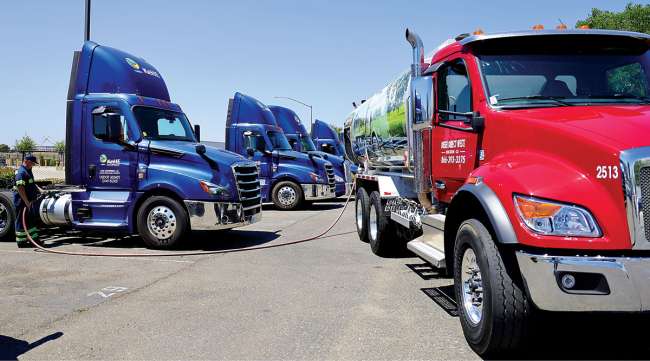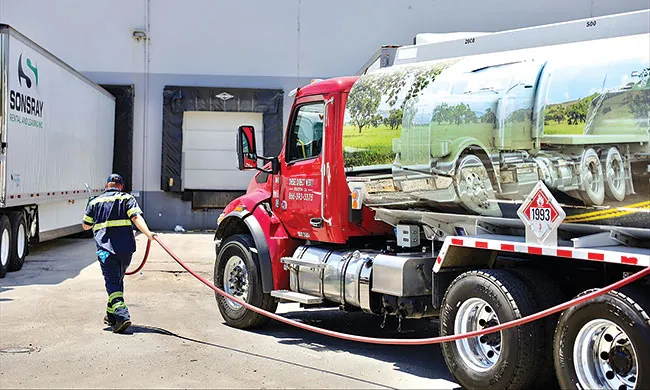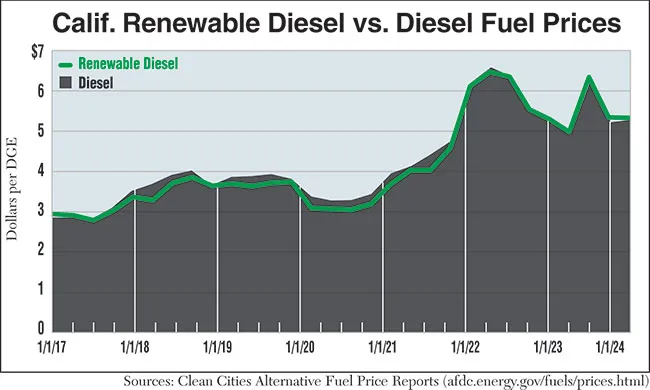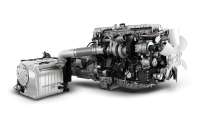US Trucking Embraces Renewable Diesel for Cleaner Operations

[Stay on top of transportation news: Get TTNews in your inbox.]
Renewable diesel as a drop-in fuel for diesel combustion engines is starting to gain traction in the U.S. trucking industry, said suppliers, distributors and federal energy researchers.
Industry interest has sparked based on the benefits that renewable diesel delivers, such as reduced carbon dioxide and nitrogen oxide emissions compared to petroleum diesel, the National Renewable Energy Laboratory said.
Renewable diesel also reduces carbon intensity on average by 65% when compared with petroleum diesel, according to California’s Low Carbon Fuel Standard Certified Carbon Intensities.
Burning renewable diesel also helps to reduce maintenance costs, said suppliers, distributors and fleet users, with reported savings of up to two cents per mile.
RELATED: ATRI Study Touts Renewable Diesel’s Benefits
Timothy Johnson, senior vice president and general manager for Stockton, Calif.-based Diesel Direct West, a distributor and user of renewable diesel, said using the fuel put an end to clogging of diesel particulate filters and the need to perform forced regeneration on the filters. Problems with exhaust gas recirculation valves also have been eliminated since Diesel Direct began using renewable diesel in its own trucks, Johnson said.

Johnson
“We bring a brand-new truck or a very used truck into our fleet, start burning renewable diesel in it, and our maintenance costs are reduced,” he said, adding that block heaters aren’t needed anymore. “The truck just starts.” The renewable fuel is produced by Neste, a company based in Finland.
RELATED: New Partnership Brings Renewable Diesel to Southeast US
Renewable diesel was at one time called green diesel. It is a hydrocarbon that meets the American Society for Testing and Materials D975 specification for petroleum diesel, the Department of Energy explains on its Alternative Fuels Data Center website. Commercial plants produce renewable diesel by hydrotreating feedstocks, such as oils and fats, AFDC says. Hydrotreating involves reacting the feedstock, which can include used cooking oil, with hydrogen under elevated temperatures and pressures in the presence of a catalyst, the AFDC website says.
In the past two years, there has been growth in the number of renewable diesel plants in the U.S., many of which are converted petroleum refineries in Western states, according to AFDC. Additional large plants are expected to come online through 2024, AFDC said, noting that the United States continues to import from Neste plants in Europe and Singapore. Neste formed a joint venture with Marathon Petroleum to convert Marathon’s petroleum refinery in Martinez, Calif., to renewable diesel production. The converted facility began production last year.

Research shows renewable diesel reduces carbon intensity on average by 65% when compared with petroleum diesel. (Diesel Direct)
After being primarily available on the West Coast, renewable diesel is starting to be introduced in other parts of the country.
This spring, Diesel Direct began supplying KW Rastall Oil of North Brunswick, N.J., with Neste renewable diesel. Rastall Oil operates a cardlock facility and a truck stop in North Brunswick. “We’ve been using it in our own trucks now for almost a year,” said Sam Rosenburgh, assistant general manager for Rastall Oil. “So we’re user, and we’re suppliers.”
In June, Sprague Operating Resources and the New York League of Conservation Voters marked the availability of renewable diesel at the Sprague Fuel Terminal in Rensselaer, N.Y. The terminal will serve trucking companies and wholesalers in upstate New York. Earlier this year, Sprague opened a retail fuel station in New York City, dispensing renewable diesel supplied from Sprague’s terminal in the Bronx.
The fuel’s continued growth depends largely on policy and legislation, particularly clean fuel programs enacted by states, experts said. California, with its Low Carbon Fuel Standard, accounts for the bulk of renewable diesel purchased and consumed in the U.S., according to the DOE’s AFDC. Oregon and Washington state also have low-carbon fuel programs.

New Mexico adopted a Clean Transportation Fuel Standard in March. It is designed to reduce greenhouse gas emissions from fuels used for transportation. The state’s Environmental Department said the purpose of the program is to encourage development of fuels that have low-carbon intensity, but the department stressed that the program is “technology-neutral, which means it does not limit or favor any technology.”
Planning is underway to create regulations that will inform how the program operates in New Mexico, the department said. The bill requires an Environmental Improvement Board to issue regulations and initiate the program no later than July 1, 2026.
Matt Leuck, Neste’s technical manager for the renewable diesel group in the Americas, said such programs allow renewable diesel producers like Neste to sell the fuel to the trucking and on-road transportation market “at near parity with fossil diesel.”
Titan Freight Systems, a less-than-truckload company that operates in Oregon, Idaho and Washington, analyzed the effect of using renewable diesel on some of its trucks. The fleet comprises electric trucks as well as trucks fueled by petroleum diesel and renewable diesel, said Keith Wilson, Titan’s president and CEO. Renewable diesel was used on a bit more than half of the fleet — 54%, in part, Wilson said, because “I could only get access to it in Oregon.” For that reason, some of the trucks were fueled with petroleum diesel. Also, some of the 50 trucks in the fleet are electric.

Wilson
The analysis showed that on the Class 8 tractors that were switched to renewable diesel, miles per gallon remained the same at 6.7, Wilson said. Reduced maintenance of exhaust systems and reduced “oil change maintenance” yielded a savings of one cent per mile for the whole fleet, Wilson said.
“Even putting in renewable diesel on a periodic basis with petroleum diesel, it still cleaned out crank cases and DPF filters,” Wilson said, referring to diesel particulate filters. “Once we switched over to renewable diesel, we had no DPF failures, no DPF cleanings and no one-box switch outs.” Wilson said as a truck company owner, he’s rarely seen a particular change “have such a profound effect on maintenance reduction and my truck uptime.” He reported a 60% reduction in CO2 emissions from Titan’s trucks using renewable diesel.
Wilson said the maintenance savings were dramatic because very little impact to the exhaust system occurs.
“You’re not putting black carbon in the crank case and so, therefore, you’re not putting black carbon in the exhaust system,” he said, adding that DPF filters and diesel exhaust fluid parts do not become corroded and contaminated.
Hydrotreated Vegetable Oil
The Engine Technology Forum, a trade group whose members include diesel engine makers, notes that renewable diesel’s refining process “results in the output of a relatively pure paraffinic compound,” hydrotreated vegetable oil (HVO), whose characteristics include “ignition properties in the engine and stability of the fuel,” enabling it to be considered a drop-in replacement for ultra-low-sulfur petroleum diesel.
Jeff Loftus of FMCSA joins TT’s Seth Clevenger to discuss the current outlook on ADAS technology and how it will affect the industry at large. Tune in above or by going to RoadSigns.ttnews.com.
Volvo Trucks North America announced in April that newly assembled trucks would be fueled with HVO before leaving the Volvo Trucks New River Valley plant in Dublin, Va. The move is part of a broader strategy to decarbonize, the OEM said. Using renewable diesel as a drop-in replacement for internal combustion engines achieves immediate emissions reductions, Volvo said.
“Because HVO is hydrogenated, it doesn’t contain oxygen and does not present the challenges of first-generation biofuels, including biodiesel, relating to extreme temperature and storage,” Volvo said in a statement. “This is an added benefit of HVO, as it does not require separate storage or fueling infrastructure.”
Kyle Zimmerman, manager of public relations for Volvo Trucks, called the switch to renewable diesel “a way for us to publicly endorse renewable diesel for our customers.”
There is a continuing need to inform and educate the public and potential users, including fleets and drivers, about renewable diesel, trucking industry figures said. A key lesson is to make known the difference between renewable diesel and biodiesel, some said.
“That’s a big thing to understand,” Zimmerman said. “They may have the same feedstock [in some cases], but they are created through an entirely different process, and you get an entirely different product.” One difference Zimmerman pointed out is that the cetane number for HVO is 71, “so it burns hotter [and] cleaner” than petroleum diesel fuel with a cetane number of 51. The cetane number is a measure of the ignition quality of a diesel fuel. The higher the number, the higher the quality.
Want more news? Listen to today's daily briefing above or go here for more info
Hydrotreating vegetable oils is one means of producing renewable diesel, and some in trucking note that there is promise in other methods and other feedstocks.
“HVO isn’t really the holy grail,” Wilson said. He added that regional waste can be used effectively as feedstock for renewable diesel.
“In Oregon, our largest regional waste is wood residual,” Wilson said. “We are the single largest producer of timber material in the United States.” He also suggested that garbage can be used efficiently as a feedstock to make renewable diesel.
More generally for the internal combustion engine’s future, experts are exploring a mix of ways forward. The North American Council for Freight Efficiency released a report last year on what it called “the messy middle” of decarbonizing heavy-duty trucking. “During the messy middle, fleets will be faced with a number of powertrain options, including advanced diesel, renewable fuels, natural gas, hydrogen, hybrids, battery-electric power and hydrogen fuel cells with no one right solution for all of the duty cycles,” NACFE said.
“The bad news about hydrogen ICE from a combustion standpoint is that hydrogen burns pretty hot, so it makes a good bit of [nitrogen oxide],” said Kevin Otto, NACFE’s electrification team lead “You have to do a lot of engineering to the combustion process to keep that NOx under control,” adding that selective catalytic reduction is likely to be required.





